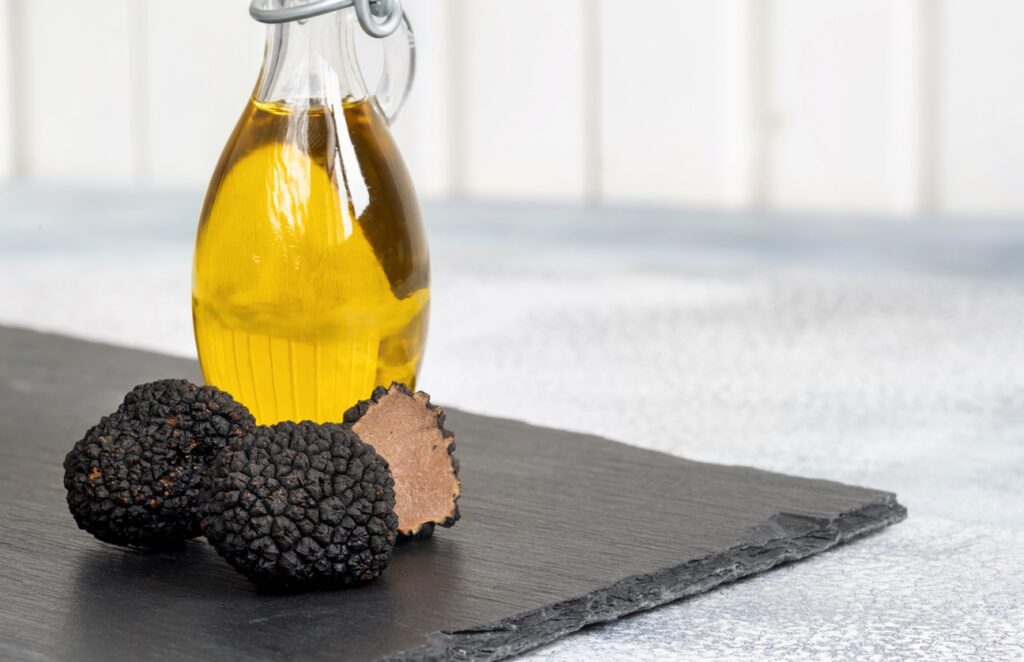
Truffle oil is the “mysterious” ingredient that adds a touch of luxury and sophistication to any dish. This culinary oil is undeniably redolent of truffles. And no, we’re not talking about the chocolate kind.
What is Truffle Oil?
Truffle oil is an aromatic oil made by infusing high-quality oil with the flavor and aroma of truffles. Truffles are a type of fungi that grow underground, usually in the roots of certain trees. They have a unique, earthy flavor and aroma that’s hard to describe, but many find it irresistible.
It is made by steeping pieces of real truffle in oil for several days or weeks, allowing the oil to absorb the truffle’s distinctive flavor and aroma. The resulting oil can then be used in a variety of dishes, adding a touch of luxury and sophistication to any meal.
How to Use Truffle Oil
Truffle oil is best used as a finishing oil, drizzled over dishes just before serving. It pairs well with pasta, risotto, pizza, salads, eggs, and meat dishes.
But be warned—a little goes a long way. This infused oil has a strong flavor and aroma that can overpower other flavors in the dish if you’re not careful. It’s also important to choose a high-quality brand that is made with real truffle extract, as some cheaper alternatives are made with synthetic flavors and can taste artificial or unpleasant.
It is often used to flavor these foods:
- pasta: works best with simple pasta dishes like spaghetti aglio e olio; simply drizzle a small amount over the pasta, toss to combine, and serve
- eggs: drizzle it over scrambled eggs or an omelet for a gourmet breakfast
- mashed potatoes: mash cooked potatoes with butter, cream, and a splash of oil
- salads: combine a small amount with high-quality balsamic vinegar for an elegant and delicious dressing.
- pizza: lightly drizzle some oil over your favorite pizza after baking
What are the drawbacks of using it?
While truffle oil can add a strong and distinctive flavor to dishes, there are several downfalls to using it:
- Lack of Authenticity: Certain brands of oil may not contain actual truffles, but rather artificial ingredients that mimic the flavor and aroma of truffles. As a result, the flavor can be inconsistent and may not taste like real truffles.
- Overuse: Because it has such a strong flavor, it can easily overpower other flavors in a dish if used too liberally. Additionally, it can lose its flavor over time, so it is important to store it properly.
- Health Concerns: Low-quality truffle oils may contain harmful chemicals such as phthalates, which are often used to enhance the scent of truffle flavorings. Phthalates have been linked to a variety of health problems, including hormone disruption and birth defects.
- Environmental Impact: The production may involve the use of environmentally damaging chemicals and practices. To minimize this negative impact, it’s important to choose products that are sustainably sourced and produced using environmentally friendly methods.
Overall, while truffle oil can add a depth of flavor to dishes, it’s important to use it in moderation so as to not overtake the flavor of a dish. Also, using oil made with real truffles can provide a more authentic and sustainable alternative.
Where to Buy Truffle Oil
Truffle oil can be found at many specialty food stores, as well as online. Look for high-quality brands made with real truffles for the best flavor. Here are some of the best quality truffle oils available:







